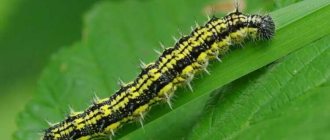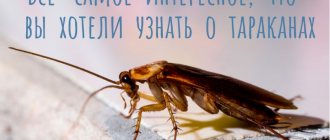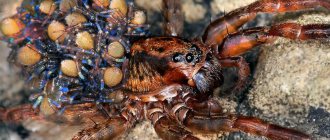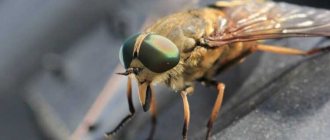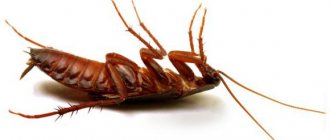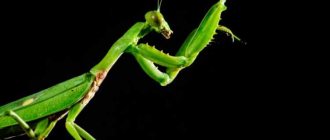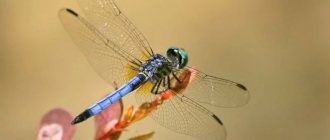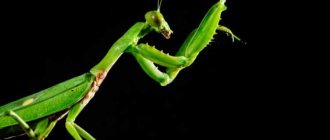Almost every adult and teenager can spot a cockroach instantly, as they see them quite often. But not everyone can answer the question of how many legs a cockroach has. The insect is brown or black in color. It depends on the type of insect. Its usual dimensions are 1.2-5.0 cm. Their head is lowered down. Males have wings, but the creature never uses them.
External structure of cockroaches
The order “cockroaches” is quite numerous and numbers up to 7 and a half thousand species. In our territories, the most numerous is the red cockroach or Prusak, as it is also called. Black cockroaches are less numerous, with the American cockroach being a fairly rare species. The structure of cockroaches, despite their species, is almost identical, although they differ in size and color.
Interesting to know! The structure of modern cockroaches is practically no different from the structure of their ancient representatives of the order “cockroaches”, in the form of Ignaroblatta, which was found in fossils. Their size was 4 times larger than the Prussians, but at the same time they were smaller in size compared to modern giant cockroaches. Moreover, they were the most numerous representatives of this genus who lived within the ancient continent of Gondwana.
The structure of their body is considered quite perfect, so it is not surprising that these insects have retained all their basic qualities for many millions of years.
The cockroach has a flattened body, which allows it to penetrate through the narrowest cracks, while the body consists of 3 parts: head, chest and abdomen.
Meet the Cockroach squad
Type: Arthropods. Class: Insects. Order: Cockroaches. This is the scientific taxonomy of creatures that are feared and hated by most of the population. In general, the general human dislike for cockroaches is quite understandable and justified. After all, these insects spoil books and food products, destroy house plants, and carry a number of dangerous diseases (for example, dysentery).
Where the word “cockroach” came from in Russian is unknown. According to one version, it comes from the Chuvash tar aqan (“runaway”). A similar-sounding word (tarqan) also exists in Turkic languages, but it is translated as “dignitary.”
Cockroaches are incredibly mobile insects that are primarily nocturnal. They prefer to settle in well-moistened and fairly warm places. They feed mainly on animal and plant debris. Legends are made about the phenomenal endurance of these insects. They are indeed resistant to radiation, but not as much as fruit flies, for example.
It should be noted that cockroaches are not perceived with hostility by people everywhere. So, in some regions of the planet they are eaten or used as medicine. In Ancient Rus' they did not even think about fighting cockroaches. The presence of these insects in the house was then considered a sign of wealth and well-being.
Head structure
The cockroach's head is triangular in shape, and it is covered on top by a shield connected to the first segment of the chest. Therefore, you can see that only the back of the head peeks out from under the shield, and the rest of the head looks down. On both sides of the head there are compound eyes consisting of 1800 fragments. As a result, the insect perceives all objects in the form of a mosaic made up of many colored pieces. The eyes of cockroaches are not designed for detailed study of objects, but at the same time, the color resolution of these insects is 5 times higher than that of humans.
Interesting fact! Thanks to the presence of compound eyes, the cockroach is able to detect individual movements that follow with a frequency of at least 300 Hz. Therefore, he is able to see the movement of an object in slow motion, which helps him timely dodge flying objects, such as a slipper, for example.
In addition to these, one might say, compound eyes, on the front of his head there are 2 simple eyes, the functions of which have not been studied to this day. Experts say that thanks to these simple eyes, the insect can navigate perfectly in the dark.
The cockroach's long whiskers serve as organs of touch, smell and temperature determination. The whiskers are distinguished by the fact that they have nerve shoots that constantly send signals to the pest’s central nervous system. With the help of their whiskers, insects contact each other, and they can transmit and perceive the necessary information. After each molt, the whiskers of individuals grow by 1 segment, so you can determine how old the cockroach is. An adult may have about 80 of them, but this does not mean that the cockroach is 80 years old. Only specialists can do the calculations.
The insect's oral apparatus has a rather interesting structure, since each part of it is designed to perform separate functions. For example:
- The upper lip (lambrum) has a movable connection with the head and on its inner surface there are receptors that signal the composition of food.
- With the help of the lower jaw (mandible), the insect firmly holds food. The lower jaws look like curved plates with sharp teeth.
- With the help of the upper jaws (maxillae), the insect chews, grinds and grinds food. They are located above the lower jaws and are armed with chemoreceptors.
- The lower lip (labium) covers the oral opening from below and consists of several parts. Thanks to the presence of this lip, food particles do not fall down. In addition, the lower lip has taste and tactile receptors that help find food and analyze its origin.
- In the cavity of the oral pharynx there is a salivary gland and something similar to a tongue, thanks to which cockroaches drink water.
It is believed that the oral apparatus of these insects has not undergone significant changes over such a long period of their existence.
10 facts about COCKROACHS that you are better off not knowing
White
You can often spot a white cockroach in an apartment. Don't think that this is some strange new species. In most cases, the cockroach has a white tint after molting. During their entire life, insects of this family shed their chitinous shell almost 10 times.
White cockroach
The light, almost transparent color makes the insect much more difficult to detect. After some time, it will be covered with a new shell and acquire a permanent color. How long will it take him to do this? In just two weeks, the mustachioed white cockroach will turn into an ordinary red or black pest.
Chemicals can affect the shade of mustachioed apartment dwellers. This happens especially often if low-quality products for killing domestic insects were purchased. After some time, the natural color will return.
The thoracic region and the purpose of the paws
On the thoracic part of the cockroach's body there are wings with elytra, as well as insect legs. Cockroaches, like any representative of the “insect” class, have 6 legs, that is, 3 pairs. Each tarsus is located on one of the thoracic segments and represents:
- Prothoracic legs, which have the shortest length and serve as “brakes” if the insect moves too quickly.
- Medium-thoracic paws that can move in any direction, providing the insect with high maneuverability.
- The metathoracic legs are designed to move the insect only forward. They are the longest in size.
The cockroach's paw is a rather complex mechanism, which includes 5 segments. The thighs, flattened in shape, are armed with spines below. The first 4 segments are armed with pads, and the fifth with claws with a suction cup located in the center. This allows the insect to crawl on both horizontal and vertical surfaces.
Interesting fact! Having relatively long legs helps the cockroach not only run fast, but also jump high. In addition, with the help of all 3 pairs of limbs, the cockroach takes care of itself from the head to the abdomen.
In other words, the insect uses 3 pairs of its legs for its intended purpose. Cockroaches are able to move along the surface at a speed of about 4 kilometers per hour. If a cockroach grew to the size of a cheetah, it could easily outrun it. With the help of sensitive hairs located on the legs, the cockroach assesses the situation around itself. In 1 minute he is able to change his trajectory up to 30 times.
Here, on the thoracic region, the wings with more rigid elytra are attached. Using the length of the wings, you can determine the gender of individuals: females have much shorter wings. These insects use their wings during the mating season, as well as when moving or falling. By spreading their wings, individuals demonstrate their readiness to mate. Despite the presence of wings, cockroaches cannot fly, although there is one species that lives in South and Central America that can fly.
Such different legs
The world around was changing, and insects were reborn. By adapting to new environmental factors, arthropods, one might say, modified themselves and reshaped their own lifestyle. Therefore, everyone’s limbs are different - it all depends on the place and living conditions. Typically, arthropods have two pairs of legs - normal, and one - special, necessary for survival. So, what types of paws are there:
- Walking beetles are strong, not capable of developing high speed, and are necessary for leisurely movement (leaf beetle).
- Runners are simple in structure, long and light, in order to develop the maximum possible speed when moving (cockroaches, ground beetles).
- Swimming - hind, with small hairs that help to stay on the water and can contribute to shallow diving (smooth bug, water strider).
- Digging - the first pair, powerful, short, stocky and flattened (dung beetle, mole cricket).
- Collective - posterior pair with long sticky hairs that serve as a basket (bumblebee, bee).
- Grasping - sharp, equipped with spines, strong, used to hold prey (mantis).
- Suction - a rear pair with a slight expansion at the end, necessary to hold the female during mating (swimmer).
- Jumping - high, strong, necessary to make a push (grasshopper).
Insect legs are the most important, vital tool. With the help of their paws, they scrupulously clean their antenna horns, wipe their eyes (as butterflies do), protect themselves from enemies and attack unexpectedly. Now it’s worth looking at a few examples - what kind of legs there are, and how representatives of the arthropod class use them. Scroll below.
How many legs does a cockroach have?
During molting, a cockroach can lose one of its precious limbs, but this happens quite rarely, and after a certain period of time the leg grows back. Also, the cockroach (male) has wings on its back, but the insect never uses them. This can be considered a useless gift from ancient ancestors. The legs of a cockroach are walking (we have already described what this means above), and each pair of limbs has its own special name:
- Prothoracic - the shortest pair, necessary for rapid braking during rapid movement.
- Medium thoracic - a pair that can turn forward and backward, acting as accelerators and decelerators when moving.
- Metathoracic - a pair that coordinates movement.
Also, the legs of a cockroach have sharp claws that allow it to crawl along walls, ceilings, cabinet doors, etc. For a cockroach, its limbs are even more important than its own head (without which, by the way, the insect can live for a month). In addition to movement, paws help wash, clean, jump and gain speed.
. Front pair
What kind of legs does a dragonfly have?
The dragonfly, which everyone often hears rather than sees (after all, the insect flies so quickly and noisily that it can be difficult to notice), also has unusual legs. It would seem that strong, elongated wings, which provide the dragonfly with excellent speed, are all that the charming representative of the fauna needs. However, the legs of the insect are not simple - on the front pair of limbs there are peculiar coarse bristles. When flying, the dragonfly places its legs so deftly that the bristles form a trap net for sweet prey.
Tiny insects, caught in such a trap (a mesh of bristles), instantly become dinner for the dragonfly.
Abdomen: structural features
A maximum of 9 abdominal segments can be distinguished, although it actually consists of 11 segments. The anus is located on the tenth segment, and the last segment is formed by paired outgrowths that have no purpose, but represent a separate sign of a certain type of cockroach. These growths have been preserved for millions of years, indicating their relict origin.
The female has a special capsule (ootheca) at the end of her abdomen, which contains 12-16 eggs and subsequently develops into the hatched larvae. Under favorable conditions (availability of water and food), this capsule appears in the female every couple of days.
Interesting to know! During the process of growth and development, not only the size of individuals changes, but also their weight, which at the beginning of development is about 2 mg, and at the end of the process about 8 mg. The larvae, in comparison with the imago, do not have wings, cerci and spines on their legs, but have short antennae. After the fifth molt, the insects develop genitals and complete external resemblance to adult cockroaches.
According to University of Massachusetts professor J. Kunkel, cockroaches are endowed with basic driving instincts, such as hunger, thirst, survival and reproduction. In order to understand whether cockroaches have a brain, you should study its internal structure.
Color spectrum
There are 2 types of cockroaches found everywhere – black and red. The first prefer damp, dark rooms; they live in sewer hatches, basements, and cellars. The latter often inhabit apartments in multi-storey buildings and even reach the upper floors. They occupy several rooms - a bathroom, a toilet, a kitchen, a corridor, a pantry.
The black cockroach has a dark color, close to black. The body is shiny, as if covered with fat. Impressive sizes up to 4 cm make insects especially noticeable.
Red Prussians are brown in different tones. The larvae are always lighter. The head is black, the last segments of the flat body are also dark in color.
The external structure of a cockroach may differ in size and color, but the internal systems of all members of the genus are the same.
Internal organs of a cockroach
According to some claims, a headless cockroach can live for several days. Such possibilities are associated with the structure of the nervous system and other organs, which allows the cockroach to live without a head.
Structure of the nervous system
The central nervous system of the cockroach is formed by 11 independent nerve ganglia. In the head of an insect there are only 2, but large, nerve nodes. They are located under and above the pharynx, and are responsible for the actions of the eyes, whiskers and probes located on the lips of the cockroach.
3 thoracic nodes, together with the subpharyngeal node, control the operation of the oral apparatus, wings, paws and head muscles, as well as the muscles of the thoracic region.
In the belly of the insect there are six small nerve ganglia, the largest of which is the terminal one, which is responsible for the functions of the genital organs and sensitive cerci.
Important point! The internal structure of the cockroach is such that it can easily do without a head, especially since its breathing is not connected to the nerve nodes located in the head. There is no pressure in his circulatory system, so he does not bleed. At the same time, he does not waste energy while being immobile, so he can easily do without food. Under certain conditions, it can live without a head for up to 1 month.
The nerve fibers of a cockroach are connected to all organs of the insect, including the sense organs. The cockroach not only has unique vision, it also has excellent hearing. The insect's auditory receptors are located near the anus.
Circulatory system
The circulatory system is of an open type, while the cockroach’s blood is white and washes all internal organs, being in free circulation. The cockroach's heart is a tubular organ located in the dorsal pericardium. The middle sinus contains the intestines, and the thoracic sinus contains the nerve cord.
Due to the work of the tubular organ, hemolymph (blood) is pumped through the circulatory system. The work of the heart is carried out due to pressure differences resulting from the work of the muscles. Blood is pumped slowly, so cockroaches are quite sensitive to changes in ambient temperature.
Respiratory system
On both sides of the abdomen there are tiny holes called spiracles, through which the insect breathes. There are 10 pairs of them, which means that on each side of the abdomen there are 10 such spiracles. From these holes extends a whole system of tubes - tracheoles, which ultimately connect with 3 pairs of several large tracheal trunks. Oxygen reaches all organs by diffusion.
Important fact! Cockroaches are able to hold their breath for up to 40 minutes, blocking their spiracles, which allows the insect to survive in difficult living conditions.
As a rule, a cockroach, being stationary, expends practically no energy. It is believed that they are in a state of movement for only 25% of their lives, so cockroaches are also considered the laziest insects.
Digestive system
When food enters the cockroach’s mouth, it is moistened with saliva (previously crushed) and enters the goiter through the esophagus, after which it is sent to the gizzard. Therefore, the process of digestion of food begins in the crop and ends in the stomach. After this, the food enters the intestine, which consists of the foregut and hindgut.
Interesting moment! The foregut consists of several parts. Immediately behind the mouth opening there is a buccal chamber with 6 teeth. With their help, the insect additionally crushes the food that has entered the mouth.
In the intestines of a cockroach there is a full range of bacteria and fungi that help the insect digest food objects, including even inedible food of inorganic origin.
Feces and urine are released through one anus. Urine is collected using special channels. They collect toxins dissolved in water throughout the body and send them to the anus.
Reproductive system
Males have a rather complex reproductive system. For example:
- The testes are located in segments 4-6 of the abdomen.
- The reproductive system includes the fungal (utricular) gland.
- The seminal vesicles empty into this gland.
- There are also organs of copulation.
- The female reproductive system is no less complex and consists of:
- From the ovaries, 8 avarioles each.
- From a pair of oviducts that are connected to the vagina.
- From the genital chamber where eggs accumulate. And collateral glands are associated with this chamber, which secrete a special secretion for the formation of a capsule (ootheca).
- From the ovipositor.
After fertilization, a capsule is formed into which the fertilized eggs enter.
Important point! The human cell nucleus includes 46 chromosomes, which are responsible for the transmission of hereditary information. Cockroaches have as many as 48 of them, although this is in no way evidence of the unique complexity of their body. Similar (relict) species of insects are distinguished by a large number of chromosomes.
According to scientists, cockroaches are more primitive, but the presence of 2 extra chromosomes indicates that the insects are quite resistant to external manifestations. It was this factor that turned out to be fundamental, ensuring the survival of the species for millions of years.
Digestive system
Cockroaches have very developed organs of the digestive system, which allows them to digest and assimilate large quantities of often protein-carbohydrate food. The digestive canal is quite long and has several loops and is divided into the following sections:
- The foregut is the stomadeum, in turn differentiated into several parts: the buccal chamber, the pharynx and the esophagus.
- The buccal region has muscular tissue and is internally equipped with six teeth, which are used for chewing food.
- The stomodeal valve, or sphincter, is present between the pharynx and the mesenteron.
- The midgut, the mesenteron, or ventricle, is short, tubular, and lined with glandular endoderm.
- At the anterior end of the mesenteron there are eight blind glandular hepatic papillae, which secrete digestive enzymes.
- The intestinal part is the proctodeum, containing the ileum, colon and rectum.
- The wall of the rectum is equipped with six rectal papillae. They help in the absorption of water and salts.
- The cockroach is an omnivorous living creature that feeds on almost all types of organic debris.
- The digestive enzymes in saliva are mainly zymase and amylase.
- Most of the nutrients in the feed are digested in the intestinal region.
- Absorption of nutrients from digested food occurs in the mesenteron.
Notes
- Robert G.
Foottit, Peter H. Adler Insect Biodiversity: science and society. - Blackwell Publishing Ltd, 2009. - P. 31. - 642 p. — ISBN 978-1-4051-5142-9 - For more details, see M. Vasmer. "Etymological dictionary of the Russian language." Volume IV, M., “Progress”, 1987, pp. 20-21, approx. O. N. Trubacheva.
- Article Cockroaches are afraid to exhale water
- www.infox.ru/science/animal/2009/08/18/Tarakanyy_boyatsya_v.phtml on the website
www.infox.ru - Article Survivors of a nuclear war... and the guillotine
- www.sciam.ru/news/2007/04/02/1442.html on the website
www.sciam.ru
The females of some cockroaches bear an ootheca at the end of their abdomen.
The giant cockroach is sometimes introduced along with bananas to temperate countries.
Uninvited guests
The structural features of cockroaches and physiology are determined by their favorite habitat - human habitation. There are all comfortable conditions here: warmth, water and darkness.
A structural feature of the cockroach order is their omnivorous nature. Their favorite treats are bread, sugar, cereals, vegetables and fruits. But if these products cannot be included in the diet, cockroaches can eat paper, fabric, glue, book binding, and any garbage. Moreover, the parasites do not completely eat the product, but bite it and look for something tastier.
Getting rid of cockroaches is often quite difficult. They get clogged into the smallest cracks, cracks, cavities in wallpaper or ceramic tiles. Therefore, all hard-to-reach places will have to be treated with chemicals.
Oral apparatus
At the bottom of the head there is an oral opening, which is surrounded by auxiliary organs, which consist of a labrum, a pair of jaws, a lower lip, and a hypopharynx. The cockroach's oral region has complex functionality and is used exclusively for biting and chewing food particles. Each of the organs of the oral apparatus performs its own functions:
- The labrum is a wide, flattened plate of sclerite running along the dorsal side of the head capsule, movably articulated with the maxilla and acting as the upper lip. The labrum has a "nasopharynx" (chemoreceptors) on its inner side.
- Mandibles, or lower jaws. Thick, tough and triangular appendages under the lip, on each side of the mouth, that contain sharp teeth called denticles.
- The maxillae, or upper jaws, are located on each side of the mouth opening, above the madibles, and are primarily used for grinding food particles and chewing. The maxillae also bear olfactory receptors.
- The lower lip and second maxilla are fused together to form one large structure that surrounds the oral opening on the ventral side, hence why it is called the “lower lip” or labium. Tactile and gustatory sensory hairs are also located here.
- Laryngopharynx. It is a small, cylindrical mouth organ located between the jaws and covered by a lip on the dorsal and ventral sides. It bears several sensory hairs at its free end, as well as the outlet of a common salivary duct on its basal surface.
How to get rid
People who first encounter insects in their homes always wonder: “Where do black cockroaches come from?” There may be several options:
- crawled from neighbors or from the basement, especially when chemical insect control is going on there;
- brought a sexually mature fertilized female with things from friends, relatives or from a trip;
- left over from past unscrupulous tenants;
- they brought an ootheca with eggs from the entrance on shoes.
How to get rid of black cockroaches - five proven methods:
Call chemical pest control specialists to treat all areas where black cockroaches may be present. This method is the fastest and most effective, but requires the temporary relocation of all family members to other housing, including pets. Strongly cool the room for several days (this method is permissible in winter at sub-zero temperatures and will only get rid of adult insects, but will not protect against subsequent hatching of young animals from deposited cocoons). Accordingly, the supply of cold air should be long-lasting, which will require a change of housing for all household members and house plants
Purchase a suitable insecticide for black cockroaches (when purchasing, you should pay attention to the instructions, contraindications and study the admissibility of use in a home with pets and small children)
Types of industrial products:
- Trap houses (for large insects) contain an intestinal poison bait that kills adult cockroaches and nymphs.
- Gels are highly effective products with a semi-liquid consistency and are attractive to all types of cockroaches because they contain water and food at the same time (mixed with toxic ingredients).
- Sprays are a convenient means for treating accumulations of insects in corners and narrow crevices; they instantly kill several dozen individuals.
- Chalks and powders (dusts) of contact action (the poison is carried on the legs of cockroaches and destroys all stages of development. Efficiency depends on the concentration of active components, most often powders give a positive result when the number of cockroaches is small.
- Take advantage of modern technologies:
- The ultrasonic repeller works on the principle of influencing the senses of black cockroaches (light and high-frequency waves), stimulating the nervous system, which forces them to leave the given home.
- An electronic trap destroys insects that come to the bait with a discharge of current. It is necessary to install several of them, and also limit the access of pets (especially small rodents).
- Use traditional methods of struggle:
- Balls with boric acid (the most effective method, requiring preparation). This bait is made from the favorite products of cockroaches with an admixture of pharmaceutical boric acid. A well-known recipe for balls: boil 1 chicken egg and potatoes, mix them with flour and vegetable oil, adding boric acid (all proportions are taken by eye). From the resulting mass, form small balls the size of a hazelnut kernel and place them in places where unwanted guests often appear. Cockroaches are great at eating treats without noticing the medicinal component in it, and in the end it kills them. This product is completely safe for pets.
- Laying out fresh bay leaves, the aroma of which insects do not like.
- Making traps from paper tape. Small houses stick the cockroaches and they cannot get out, dying of hunger.
Household pests in the former Soviet Union
In Russia and in countries such as: Azerbaijan, Armenia, Belarus, etc. it is possible to meet about fifty such cohabitants. A person is not able to see all representatives of these pests. In the photographs below you can recognize your roommates.
But the common people call them completely differently. Some call him Prusak, and others affectionately call him “Stasik”. All conditions for living in the apartments have been created. It’s always warm, there is water in the bathroom and kitchen, and as for food, there are no problems at all. Enjoy life as much as you like. An excellent option for life.
The next representative of the cockroaches is black or scientifically Blattaorientalis:
Behavior
Research into the behavior of cockroaches began relatively recently. In addition to caring for offspring in Cryptocercus
, they showed the presence of group behavior in synatropic species. Thus, experiments conducted at the University of Florida demonstrated that a cockroach leaves behind a chemical trail that other cockroaches will use to quickly find their way to sources of water, food or shelter.
One of the main goals of this research was to develop new methods for controlling cockroaches as pests. An artificially created chemical trail leading away from the home could solve the cockroach problem without the use of toxic insecticides.
Interesting Facts
Due to the fact that black cockroaches have been known to mankind for more than 3 centuries, various beliefs and unusual facts associated with these insects have appeared at different times. For example, in the old days, cockroaches often hid behind a warm stove, which is why they began to be called “baked dwellers.”
There was also a legend that the appearance of black barbels in the house promised wealth to the owners, so they even fed them and took them with them when moving to a new home. Ancient healers prepared a healing potion from cockroaches, used for digestive disorders. It consisted of garlic and insects fried in oil.
Tea made from dried cockroaches has also been used in medicine as a diuretic. Modern medicine regarding cockroaches reports a high percentage of allergic reactions to insects among young children living in large cities (approximately 45%).
In Asian countries such as Thailand, South Korea, Cambodia and Vietnam, cockroaches are still considered an essential component of many national dishes. They are eaten fried, stewed and dried, and are also offered to all tourists to try. Such food preferences are explained by the high content of high-quality protein in the body of insects.
Scientists entomologists, in the process of many years of studying various insects, discovered an interesting fact that cockroaches are not affected by radiation due to their slow biological processes.
According to archaeological excavations, cockroaches appeared during the period of dinosaurs and reached sizes of 50 cm in length or more. Modern data confirms another fact - cockroaches are able to sense the approach of heavy rain, which is why they diligently rush to take cover even at night.
The life of cockroaches is inextricably linked with human life, which is why there are frequent cases of dreams involving these insects. To understand why black cockroaches are dreamed of, you should turn to specialized interpretative books.
For the most part, such dreams report joyful events, success in business and well-being (even if there were a lot of insects and they attacked a person).
A dream involving gigantic cockroaches can be a warning about possible intrigues on the part of influential relatives or friends. But if a white cockroach appears in a dream, you should expect trouble.
Food nearby
How long can a cockroach survive without food? Left without water, black kitchen cockroaches can live for a week to a week. When cockroaches have water but are deprived of food, they can survive for months. However, they will die faster if you give them dry food but no water.
We use food for cockroaches against them
Forms of release of poisoned baits.
Since cockroach poison is available in various forms, useful tips for using them vary:
In specialized stores, you most often find various ready-made baits placed in special boxes. These are commonly called insecticide traps. Various gels and pastes against cockroaches are widely used: they contain liquefied edible substrates saturated with poisons. Concentrates are sold in plastic bottles of various sizes, their price is quite high
They are more difficult to find freely available than granules or tablets, since they can only be handled by professional pest control stations who know the precautions and know how to prepare poison from highly concentrated poisons. Completely ready-to-use baits are produced in the form of granules and tablets, which need to be placed only in the corners.
Cockroaches have adapted and learned to avoid sweetened poison. For decades, people have been getting rid of cockroaches by putting out bait mixed with poison. But then the killer product stopped working. Cockroach populations continued to increase. Many of the cockroaches have stopped eating sweets, abandoning the corn syrup that was designed to attract them. For many years now, the sign of sugar withdrawal has become so common that the bait has become useless.
A genetic mutation gave some cockroaches a competitive advantage that allowed them to survive and reproduce. The key is certain neurons that signal the brain to eat. In normal cockroaches, glucose excites neurons that tell the brain “Sweet!” In mutant insects, glucose activates neurons that say “Sweet!” and those who say “Ugh!”, “Ugh!” the neurons attenuate the signal from others, so the brain gets the message that the taste is terrible. This unusual neural activity was observed in glucose-hating cockroaches.
Interesting Facts
- In a second, an insect can run 75 cm.
- Cockroaches are very maneuverable - they can change the trajectory of their movement up to 25 times per second.
- The insect can live without a head for 10 days, a month without food and a week without water.
- Cockroaches breathe with their whole body and are able to hold their breath for 40 minutes.
- A person can survive exposure to 500 rads, while a cockroach can withstand 6400 rads.
- During life, the insect releases gases every 15 minutes, and after death it continues to release them for another 18 hours.
- If a cockroach is turned on its back, it will never turn back and will lie there until it dies from thirst or hunger.
- Cockroaches easily move from one country to another and immediately take root in a new place.
The black cockroach is distributed throughout Europe and is found in close proximity to human habitation.
What do they eat?
In the process of evolution, cockroaches have adapted to the most extreme living conditions, and also learned to eat any food, even seemingly inedible at first glance. Among the foods that a cockroach can eat:
- spoiled food;
- plant leaves, fruits, vegetables;
- paper;
- soap;
- fabric, leather, wood.
Even though insects are omnivores, they still have food preferences. So, what do cockroaches love most:
- sugar;
- sweets;
- baking;
- meat and meat products.
Dinner
In case of acute food shortage, cockroaches can attack people, biting off pieces of skin, and also eat dead relatives.
Nutrition
In natural conditions, most cockroaches are vegetarians; they eat fallen leaves, fruits, and dead plants. Some species are omnivores, their diet expanded to include the remains and excrement of animals. Domestic insects feed on any food found in the apartment. Preference is given to sweets, bread and pastries, as well as fruits. You will learn about the diet of domestic pests in the material “What do cockroaches eat: what diet should you prepare at home?”
Redheads (Blattella germanica)
If we consider the types of domestic cockroaches, this is the most popular family. It is also known as Prussians. No living space is immune from the appearance of red cockroaches.
Types of cockroaches
You can meet red cockroaches almost everywhere:
- Living spaces;
- hospitals;
- public places;
- utility rooms;
- country houses.
The body of the cockroach is slightly elongated, the chitinous shell has a reddish tint, which can range from light to very dark. Representatives of such an interesting family live near a large amount of food. Incredibly, they easily manage to penetrate even closed containers.
Types of red cockroaches
Interesting facts from the life of red cockroaches - they can find food almost everywhere. Even if you carefully hide all the leftover food, insects will easily find a few grains of sugar spilled a long time ago or stale bread crumbs.
Interesting Facts
- In a second, an insect can run 75 cm.
- Cockroaches are very maneuverable - they can change the trajectory of their movement up to 25 times per second.
- The insect can live without a head for 10 days, a month without food and a week without water.
- Cockroaches breathe with their whole body and are able to hold their breath for 40 minutes.
- A person can survive exposure to 500 rads, while a cockroach can withstand 6400 rads.
- During life, the insect releases gases every 15 minutes, and after death it continues to release them for another 18 hours.
- If a cockroach is turned on its back, it will never turn back and will lie there until it dies from thirst or hunger.
- Cockroaches easily move from one country to another and immediately take root in a new place.
The black cockroach is distributed throughout Europe and is found in close proximity to human habitation.
